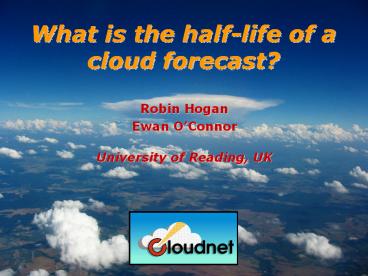Robin Hogan PowerPoint PPT Presentation
Title: Robin Hogan
1
What is the half-life of a cloud forecast?
- Robin Hogan
- Ewan OConnor
- University of Reading, UK
2
Cloud fraction Bony diagrams
- Winter (Oct-Mar) Summer (Apr-Sep)
ECMWF model Chilbolton
3
with snow
Winter (Oct-Mar) Summer (Apr-Sep)
ECMWF model Chilbolton
4
How good is a forecast?
- Most model comparisons evaluate the cloud
climatology - What about individual forecasts?
- Standard measure shows forecast half-life of 8
days (left) - But virtually insensitive to clouds!
ECMWF 500-hPa geopotential anomaly correlation
- Overview of talk
- Which skill scores have the most desirable
properties? - How does skill depend on spatial scale, lead time
etc? - If it has an inverse-exponential decay with
forecast lead time, what is the half-life of
the forecast?
5
(No Transcript)
6
Joint PDFs of cloud fraction
- Raw (1 hr) resolution
- 1 year from Murgtal
- DWD COSMO model
7
Desirable properties of skill scores
- Equitable all random forecasts score zero
- This is essential!
- Note that forecasting the right climatology
versus height but with no other skill should also
score zero - Proper not possible to hedge your bets
- Some scores reward under- or over-prediction
(e.g. hit rate) - Jolliffe and Stephenson not possible to be
equitable and proper! - Independence of how often cloud occurs
- Almost all scores asymptote to 0 or 1 for
vanishingly rare events - Dependence on 10x10 joint PDF, not just 2x2 table
- Difference between cloud fraction of 0.9 and 1 is
as important for radiation as a difference
between 0 and 0.1 - Linearity so that can fit an inverse exponential
- Some scores (Yules Q) saturate at the
high-skill end
8
Three quite good scores
- 1. Log of odds ratio LORln(ad/bc)
- Good properness properties
- Unbounded a perfect forecast scores infinity!
- Generalized skill score (x-xrandom)/(xperfect-xr
andom) - Where x is any number derived from the joint
PDF - Resulting scores vary linearly from random0 to
perfect1 - 2. Heidke skill score xad
- Monotonically related to the Equitable Threat
Score, but more linear - 3. Linear Brier score xmean absolute difference
- Sensitive to cloud fraction errors in model for
all values of cloud fraction
9
Score versus lead time, Murgtal 2007
- Both scores well fitted by SS0exp(-t/t0)
- Half lifeln(2)t0
- Met Office NAE has higher scores than DWD COSMO
- But apparently a shorter half life (2.7 days
versus 4.1 days) - Obviously need longer lead-time forecasts to
check this!
10
DWD COSMO versus hours averaged
- Skill and lead time both increase with the number
of hours over which cloud fraction is averaged - Larger-scale features are easier to forecast
11
Met Office versus hours averaged
- Statistics poorer for larger number of hours
averaged - Log of odds ratio and Heidke skill score are
sensitive to cloud fraction threshold - Linear Brier score considers all cloud fractions
so more robust
12
Summary
- Half-life of a cloud forecast is between 2.5 and
5 days - Relatively insensitive to skill score (provided a
good one is used) - Compare to 8 days for ECMWF 500-hPa geopotential
height forecast - Skill at forecasting cloud increases somewhat for
larger scale features - Important to assess the merits of various skill
scores - At least 5 criteria to judge against, and none
are good on all - Plenty of bad ones to use (hit rate, false-alarm
rate etc)! - Worth trying Stephensonss Extreme Dependency
Score, which is good for very rare events - Wish list
- Obtain Met Office cloud forecasts beyond a lead
time of 3 days - Compare skill of the Met Office model at
different model resolutions, but averaged to the
same scale - Can we see what skill comes from global model at
boundaries, what comes from mesoscale data
assimilation etc?
13
(No Transcript)
14
Contingency tables
Comparison with Met Office model over
Chilbolton October 2003
Observed cloud Observed clear-sky
- Model cloud
- Model clear-sky
A Cloud hit B False alarm
C Miss D Clear-sky hit
15
Simple skill scoreHit Rate
Met Office short range forecast
Météo France old cloud scheme
- Hit Rate fraction of forecasts correct
(AD)/(ABCD) - Consider all Cabauw data, 1-9 km
- Increase in cloud fraction threshold causes
apparent increase in skill.
16
Scores independent of clearsky hits
- False alarm rate fraction of forecasts of cloud
which are wrong B/(AB) - perfect forecast is 0
- Probability of detection fraction of clouds
correctly forecast A/(AC) - perfect forecast is 1
- Skill decreases as cloud fraction threshold
increases
17
More sophisticated scores
- Equitable threat score (A-E)/(ABC-E) where E
removes those hits that occurred by chance.
- Yules Q (?-1)/(?1) where the odds ratio
?AD/BC. - Advantage little dependence on frequency of cloud
- For both scores, 1 perfect forecast, 0 random
forecast - From now on use Equitable threat score with
threshold of 0.1.
18
Skill versus height
- Model performance
- ECMWF, RACMO, Met Office models perform similarly
- Météo France not so well, much worse before April
2003 - Met Office model significantly better for shorter
lead time - Potential for testing
- New model parameterisations
- Global versus mesoscale versions of the Met
Office model
19
Monthly skill versus time
- Measure of the skill of forecasting cloud
fractiongt0.05 - Comparing models using similar forecast lead time
- Compared with the persistence forecast
(yesterdays measurements) - Lower skill in summer convective events
20
Skill versus lead time
- Unsurprisingly UK model most accurate in UK,
German model most accurate in Germany!
- Half-life of cloud forecast 2 days
- More challenging test than 500-hPa geopotential
(half-life 8 days)

